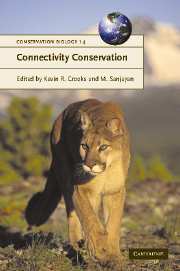Book contents
- Frontmatter
- Contents
- List of contributors
- Acknowledgements
- 1 Connectivity conservation: maintaining connections for nature
- PART I Approaches to connectivity research
- PART II Assessing connectivity
- PART III Challenges and implementation of connectivity conservation
- Introduction: Don't fence me in
- 18 Hyperconnectivity, invasive species, and the breakdown of barriers to dispersal
- 19 Disease and connectivity
- 20 Maintaining and restoring connectivity in landscapes fragmented by roads
- 21 Where to draw the line: integrating feasibility into connectivity planning
- 22 South Coast Missing Linkages: restoring connectivity to wildlands in the largest metropolitan area in the USA
- 23 Incorporating connectivity into broad-scale conservation planning
- 24 Escaping the minimalist trap: design and implementation of large-scale biodiversity corridors
- 25 The role of connectivity in Australian conservation
- 26 The future of connectivity conservation
- Index
- References
21 - Where to draw the line: integrating feasibility into connectivity planning
Published online by Cambridge University Press: 24 May 2010
- Frontmatter
- Contents
- List of contributors
- Acknowledgements
- 1 Connectivity conservation: maintaining connections for nature
- PART I Approaches to connectivity research
- PART II Assessing connectivity
- PART III Challenges and implementation of connectivity conservation
- Introduction: Don't fence me in
- 18 Hyperconnectivity, invasive species, and the breakdown of barriers to dispersal
- 19 Disease and connectivity
- 20 Maintaining and restoring connectivity in landscapes fragmented by roads
- 21 Where to draw the line: integrating feasibility into connectivity planning
- 22 South Coast Missing Linkages: restoring connectivity to wildlands in the largest metropolitan area in the USA
- 23 Incorporating connectivity into broad-scale conservation planning
- 24 Escaping the minimalist trap: design and implementation of large-scale biodiversity corridors
- 25 The role of connectivity in Australian conservation
- 26 The future of connectivity conservation
- Index
- References
Summary
INTRODUCTION
The long-term persistence of populations in fragmented landscapes depends on connectivity among disjunct habitat patches. Retaining or restoring habitat corridors has become a dominant strategy for maintaining connectivity in fragmented landscapes (e.g., Bennett 1999; Groves 2003; this volume), especially when the surrounding matrix is hostile to dispersing wildlife. The biological merits of any particular corridor, however, will depend upon a variety of factors, including the ecology of the targets (species, communities, natural processes) it is intended to serve, as well as the specific attributes of the corridor itself, the habitat matrix in which it is embedded, and the core areas it is connecting. Often, the effects of corridors on target biota are unknown. In some cases, corridors may be ineffective or even counter-productive (e.g., Simberloff and Cox 1987; Hess 1994; Dobson et al. 1999; Crooks and Suarez Chapter 18). Biological advantages and disadvantages of corridors have been discussed elsewhere (e.g., Beier and Noss 1998; Groves 2003; Crooks and Sanjayan Chapter 1). Here, we focus on how feasibility considerations factor into the decision-making process of conservation practitioners deciding where best to invest resources in connectivity conservation.
In an ideal world, wildlife corridor planning would occur with detailed knowledge of biological resource needs, multiple options for corridor design, unlimited resources for implementation, and cooperative landowners. More often, virtually nothing is known about plant and animal movement needs within a landscape, human land uses have already greatly constrained corridor options, conservation funding is inadequate, and landowners and political entities are recalcitrant (Swenson and Franklin 2000).
- Type
- Chapter
- Information
- Connectivity Conservation , pp. 536 - 554Publisher: Cambridge University PressPrint publication year: 2006
References
- 5
- Cited by

